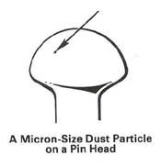
Micrometre
Encyclopedia
A micrometer is by definition 1×10-6 of a meter (SI Standard prefix "micro" = 10-6).
In plain English, it means one-millionth of a meter (or one-thousandth of a millimeter, or 0.001 mm). Its unit symbol in the International System of Units
(SI) is μm. The latter may be rendered as um if Greek fonts are not available or not admissible.
The term micron and the symbol μ, representing the micrometre were officially accepted between 1879 and 1967, but officially revoked by the ISI in 1967.
In practice, "micron" is a widely used term in preference to "micrometre" in many English-speaking countries, and in American English
the use of the term helps differentiate the unit from the micrometer
, a measuring device, which would otherwise be spelled as a homonym
with micrometre. The term "micron" has particular currency in science, and is extensively used in most English-speaking countries in the fields of geology
, biology
, physics
, astronomy
, and the semiconductor industry
.
The micrometre is a common unit of measurement
for wavelength
s of infrared radiation.
In plain English, it means one-millionth of a meter (or one-thousandth of a millimeter, or 0.001 mm). Its unit symbol in the International System of Units
International System of Units
The International System of Units is the modern form of the metric system and is generally a system of units of measurement devised around seven base units and the convenience of the number ten. The older metric system included several groups of units...
(SI) is μm. The latter may be rendered as um if Greek fonts are not available or not admissible.
The term micron and the symbol μ, representing the micrometre were officially accepted between 1879 and 1967, but officially revoked by the ISI in 1967.
In practice, "micron" is a widely used term in preference to "micrometre" in many English-speaking countries, and in American English
American English
American English is a set of dialects of the English language used mostly in the United States. Approximately two-thirds of the world's native speakers of English live in the United States....
the use of the term helps differentiate the unit from the micrometer
Micrometer
A micrometer , sometimes known as a micrometer screw gauge, is a device incorporating a calibrated screw used widely for precise measurement of small distances in mechanical engineering and machining as well as most mechanical trades, along with other metrological instruments such as dial, vernier,...
, a measuring device, which would otherwise be spelled as a homonym
Homonym
In linguistics, a homonym is, in the strict sense, one of a group of words that often but not necessarily share the same spelling and the same pronunciation but have different meanings...
with micrometre. The term "micron" has particular currency in science, and is extensively used in most English-speaking countries in the fields of geology
Geology
Geology is the science comprising the study of solid Earth, the rocks of which it is composed, and the processes by which it evolves. Geology gives insight into the history of the Earth, as it provides the primary evidence for plate tectonics, the evolutionary history of life, and past climates...
, biology
Biology
Biology is a natural science concerned with the study of life and living organisms, including their structure, function, growth, origin, evolution, distribution, and taxonomy. Biology is a vast subject containing many subdivisions, topics, and disciplines...
, physics
Physics
Physics is a natural science that involves the study of matter and its motion through spacetime, along with related concepts such as energy and force. More broadly, it is the general analysis of nature, conducted in order to understand how the universe behaves.Physics is one of the oldest academic...
, astronomy
Astronomy
Astronomy is a natural science that deals with the study of celestial objects and phenomena that originate outside the atmosphere of Earth...
, and the semiconductor industry
Semiconductor industry
The semiconductor industry is the aggregate collection of companies engaged in the design and fabrication of semiconductor devices. It formed around 1960, once the fabrication of semiconductors became a viable business...
.
The micrometre is a common unit of measurement
Measurement
Measurement is the process or the result of determining the ratio of a physical quantity, such as a length, time, temperature etc., to a unit of measurement, such as the metre, second or degree Celsius...
for wavelength
Wavelength
In physics, the wavelength of a sinusoidal wave is the spatial period of the wave—the distance over which the wave's shape repeats.It is usually determined by considering the distance between consecutive corresponding points of the same phase, such as crests, troughs, or zero crossings, and is a...
s of infrared radiation.
See also
- Metric systemMetric systemThe metric system is an international decimalised system of measurement. France was first to adopt a metric system, in 1799, and a metric system is now the official system of measurement, used in almost every country in the world...
- Si prefixSI prefixThe International System of Units specifies a set of unit prefixes known as SI prefixes or metric prefixes. An SI prefix is a name that precedes a basic unit of measure to indicate a decadic multiple or fraction of the unit. Each prefix has a unique symbol that is prepended to the unit symbol...
- Orders of magnitude
- Wool measurement

